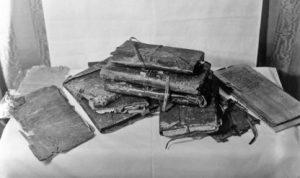Nicola Denzey Lewis at The Marginalia Review of Books:
 The find story of the Nag Hammadi codices is well known to anyone who works in the field of Gnosticism or early Christian literature. There is no point in rehearsing the beginning of the story here in detail; it can be distilled into these central themes: an illiterate peasant, a search for fertilizer gone awry, and the fortuitous discovery of a mysterious jar deep in the Egyptian wilderness containing ancient secret books. But the story does not end there. In this tale of intrigue, the codices themselves emerge as the new romantic heroines of the story. Narrowly escaping their own destruction by fire, the books are hidden and then smuggled, alternately recognized for their value and treated as virtually worthless, passed through multiple hands of people who only exploit them, and hastily dumped or traded for a scandalous price: some tea, some sugar, a bag of oranges. According to the common story, the codices are even witnesses to a gory act of murder, “the ultimate act of blood vengeance,” as Mohamed Ali al-Samman, the peasant in question, slaughters with his brothers the man who a few months before killed their father, tearing out his heart and “devouring it on the spot.”
The find story of the Nag Hammadi codices is well known to anyone who works in the field of Gnosticism or early Christian literature. There is no point in rehearsing the beginning of the story here in detail; it can be distilled into these central themes: an illiterate peasant, a search for fertilizer gone awry, and the fortuitous discovery of a mysterious jar deep in the Egyptian wilderness containing ancient secret books. But the story does not end there. In this tale of intrigue, the codices themselves emerge as the new romantic heroines of the story. Narrowly escaping their own destruction by fire, the books are hidden and then smuggled, alternately recognized for their value and treated as virtually worthless, passed through multiple hands of people who only exploit them, and hastily dumped or traded for a scandalous price: some tea, some sugar, a bag of oranges. According to the common story, the codices are even witnesses to a gory act of murder, “the ultimate act of blood vengeance,” as Mohamed Ali al-Samman, the peasant in question, slaughters with his brothers the man who a few months before killed their father, tearing out his heart and “devouring it on the spot.”
Even as find stories of ancient documents go, this tale has many compelling elements: a mysterious and exciting discovery; an almost lovably superstitious protagonist; a clueless old woman who almost ruins everything by tossing precious manuscript pages in the fire; exotically dangerous fellaheen who ride through the desert on camels or in jeeps, brandishing rifles and scimitars and whatever else they use to slaughter one another; and finally a happy resolution as the codices are rescued from an ignominious fate and delivered safely into the knowing hands of Western scholars. It’s thoroughly Orientalizing, and, when you think about its lurid details, quite implausible.
more here.
